Basalt/Wood Hybrid Composites Based on Polypropylene: Morphology, Processing Properties, and Mechanical and Thermal Expansion Performance
Abstract
1. Introduction
2. Materials and Methods
2.1. Materials
2.2. Methods of Testing
2.2.1. Determination of True and Theoretical Density
2.2.2. Water Absorption
2.2.3. Mechanical Testing
2.2.4. Rule of Hybrid Mixtures
2.2.5. Halpin–Tsai Equation
- E is the elastic modulus
- V is the volume fraction
- l is length of the fiber
- d is diameter of the fiber
- m is matrix
- f1 and f2 are first fiber and second fiber, respectively.
2.2.6. Vicat Softening Temperature Measurement
2.2.7. Linear Shrinkage
2.2.8. Composite Morphology
2.2.9. Thermal Expansion
3. Results and Discussion
3.1. Physical and Processing Properties
3.2. Static Tensile Test
3.3. Flexural Properties
3.4. Rule of Hybrid Mixture and Halpin–Tsai equation
3.5. Charpy Impact Test
3.6. Thermal Expansion
3.7. Water Absorption
3.8. Fractographic Investigation
4. Conclusions
Author Contributions
Funding
Acknowledgments
Conflicts of Interest
References
- Klyosov, A.A. Wood-Plastic Composites; John Wiley & Sons, Inc.: Hoboken, NJ, USA, 2007; ISBN 9780470165935. [Google Scholar]
- Wu, Q.; Chi, K.; Wu, Y.; Lee, S. Mechanical, thermal expansion, and flammability properties of co-extruded wood polymer composites with basalt fiber reinforced shells. Mater. Des. 2014, 60, 334–342. [Google Scholar] [CrossRef]
- Ashori, A.; Nourbakhsh, A. Bio-based composites from waste agricultural residues. Waste Manag. 2010, 30, 680–684. [Google Scholar] [CrossRef] [PubMed]
- Thakur, V.K.; Thakur, M.K.; Pappu, A. Hybrid Polymer Composite Materials: Properties and Characterisation; Woodhead Publishing: Cambridge, UK, 2017; ISBN 9780081007877. [Google Scholar]
- Fiore, V.; Scalici, T.; Di Bella, G.; Valenza, A. A review on basalt fibre and its composites. Compos. Part B Eng. 2015, 74, 74–94. [Google Scholar] [CrossRef]
- Singha, K. A Short Review on Basalt Fiber. Int. J. Text. Sci. 2012, 2012, 19–28. [Google Scholar]
- Li, Z.; Ma, J.; Ma, H.; Xu, X. Properties and Applications of Basalt Fiber and Its Composites. In IOP Conference Series: Earth and Environmental Science; IOP Publishing: Banda Aceh, Indonesia, 2018; Volume 186. [Google Scholar]
- Chen, J.; Wang, Y.; Gu, C.; Liu, J.; Liu, Y.; Li, M.; Lu, Y. Enhancement of the Mechanical Properties of Basalt Fiber-Wood-Plastic Composites via Maleic Anhydride Grafted High-Density Polyethylene (MAPE) Addition. Materials (Basel) 2013, 6, 2483–2496. [Google Scholar] [CrossRef] [PubMed]
- Turku, I.; Kärki, T. The effect of carbon fibers, glass fibers and nanoclay on wood flour-polypropylene composite properties. Eur. J. Wood Wood Prod. 2014, 72, 73–79. [Google Scholar] [CrossRef]
- Al-Maadeed, M.A.; Shabana, Y.M.; Khanam, P.N. Processing, characterization and modeling of recycled polypropylene/glass fibre/wood flour composites. Mater. Des. 2014, 58, 374–380. [Google Scholar] [CrossRef]
- AlMaadeed, M.A.; Kahraman, R.; Noorunnisa Khanam, P.; Madi, N. Date palm wood flour/glass fibre reinforced hybrid composites of recycled polypropylene: Mechanical and thermal properties. Mater. Des. 2012, 42, 289–294. [Google Scholar] [CrossRef]
- Valente, M.; Sarasini, F.; Marra, F.; Tirillò, J.; Pulci, G. Hybrid recycled glass fiber/wood flour thermoplastic composites: Manufacturing and mechanical characterization. Compos. Part A Appl. Sci. Manuf. 2011, 42, 649–657. [Google Scholar] [CrossRef]
- Deák, T.; Czigány, T. Chemical Composition and Mechanical Properties of Basalt and Glass Fibers: A Comparison. Text. Res. J. 2009, 79, 645–651. [Google Scholar] [CrossRef]
- Jamshaid, H.; Mishra, R. A green material from rock: Basalt fiber—A review. J. Text. Inst. 2016, 107, 923–937. [Google Scholar] [CrossRef]
- Pak, S.; Park, S.; Song, Y.S.; Lee, D. Micromechanical and dynamic mechanical analyses for characterizing improved interfacial strength of maleic anhydride compatibilized basalt fiber/polypropylene composites. Compos. Struct. 2018, 193, 73–79. [Google Scholar] [CrossRef]
- Prajapati, R.S.; Jain, S.; Shit, S.C. Development of basalt fiber-reinforced thermoplastic composites and effect of PE-g-MA on composites. Polym. Compos. 2017, 38, 2798–2805. [Google Scholar] [CrossRef]
- Chen, J.X.; Guan, S.J.; Zhang, S.H.; Zheng, J.J.; Xie, J.; Lu, Y. Development of Basalt Fiber Reinforced Wood-Plastic Composite Materials. Adv. Mater. Res. 2011, 189–193, 4043–4048. [Google Scholar] [CrossRef]
- Lu, G.; Wang, W.; Shen, S. Mechanical Properties of Wood Flour Reinforced High Density Polyethylene Composites with Basalt Fibers. Mater. Sci. 2014, 20, 464–467. [Google Scholar] [CrossRef]
- Greco, A.; Maffezzoli, A.; Casciaro, G.; Caretto, F. Mechanical properties of basalt fibers and their adhesion to polypropylene matrices. Compos. Part B Eng. 2014, 67, 233–238. [Google Scholar] [CrossRef]
- Pickering, K.L.; Efendy, M.G.A.; Le, T.M. A review of recent developments in natural fibre composites and their mechanical performance. Compos. Part A Appl. Sci. Manuf. 2016, 83, 98–112. [Google Scholar] [CrossRef]
- Kuciel, S.; Kufel, A. Novel hybrid composite based on polypropylene with basalt/carbon. Polimery 2018, 63, 387–390. [Google Scholar] [CrossRef]
- Fu, S.-Y.; Xu, G.; Mai, Y.-W. On the elastic modulus of hybrid particle/short-fiber/polymer composites. Compos. Part B Eng. 2002, 33, 291–299. [Google Scholar] [CrossRef]
- Mansor, M.R.; Sapuan, S.M.; Zainudin, E.S.; Nuraini, A.A.; Hambali, A. Stiffness Prediction of Hybrid Kenaf/Glass Fiber Reinforced Polypropylene Composites using Rule of Mixtures (ROM) and Rule of Hybrid Mixtures (RoHM). J. Polym. Mat. 2013, 30, 321–334. [Google Scholar]
- Mirbagheri, J.; Tajvidi, M.; Hermanson, J.C.; Ghasemi, I. Tensile properties of wood flour/kenaf fiber polypropylene hybrid composites. J. Appl. Polym. Sci. 2007, 105, 3054–3059. [Google Scholar] [CrossRef]
- Wu, L.P.; Kang, W.L.; Chen, Y.; Zhang, X.; Lin, X.H.; Chen, L.Y.; Gai, J.G. Structures and properties of low-shrinkage polypropylene composites. J. Appl. Polym. Sci. 2017, 134, 1–9. [Google Scholar] [CrossRef]
- Tripathi, D. Rapra Practical Guide Series Practical Guide to Polypropylene; Smithers Rapra Press: Akron, OH, USA, 2002; ISBN 1859572820. [Google Scholar]
- Coutinho, F.M.B.; Costa, T.H.S. Performance of polypropylene—Wood fiber composites. Polym. Test. 1999, 18, 581–587. [Google Scholar] [CrossRef]
- Sang, L.; Zheng, G.; Hou, W.; Yang, X.; Wei, Z. Crystallization and mechanical properties of basalt fiber-reinforced polypropylene composites with different elastomers. J. Therm. Anal. Calorim. 2018, 134, 1531–1543. [Google Scholar] [CrossRef]
- Arencón, D.; Velasco, J.I. Fracture toughness of polypropylene-based particulate composites. Materials (Basel) 2009, 2, 2046–2094. [Google Scholar] [CrossRef]
- Yang, H.-S.; Wolcott, M.P.; Kim, H.-S.; Kim, H.-J. Thermal properties of lignocellulosic filler-thermoplastic polymer bio-composites. J. Therm. Anal. Calorim. 2005, 82, 157–160. [Google Scholar] [CrossRef]
- Stark, N. Influence of moisture absorption on mechanical properties of wood flour-polypropylene composites. J. Thermoplast. Compos. Mater. 2001, 14, 421–432. [Google Scholar] [CrossRef]
- Kada, D.; Migneault, S.; Tabak, G.; Koubaa, A. Physical and mechanical properties of polypropylene-wood-carbon fiber hybrid composites. BioResources 2016, 11, 1393–1406. [Google Scholar] [CrossRef]
- Bhaskar, J.; Haq, S.; Yadaw, S. Evaluation and testing of mechanical properties of wood plastic composite. J. Thermoplast. Compos. Mater. 2012, 25, 391–401. [Google Scholar] [CrossRef]
- Karger-Kocsis, J.; Bárány, T. Polypropylene Handbook; Springer International Publishing: Cham, Switzerland, 2019; ISBN 9783030129026. [Google Scholar]
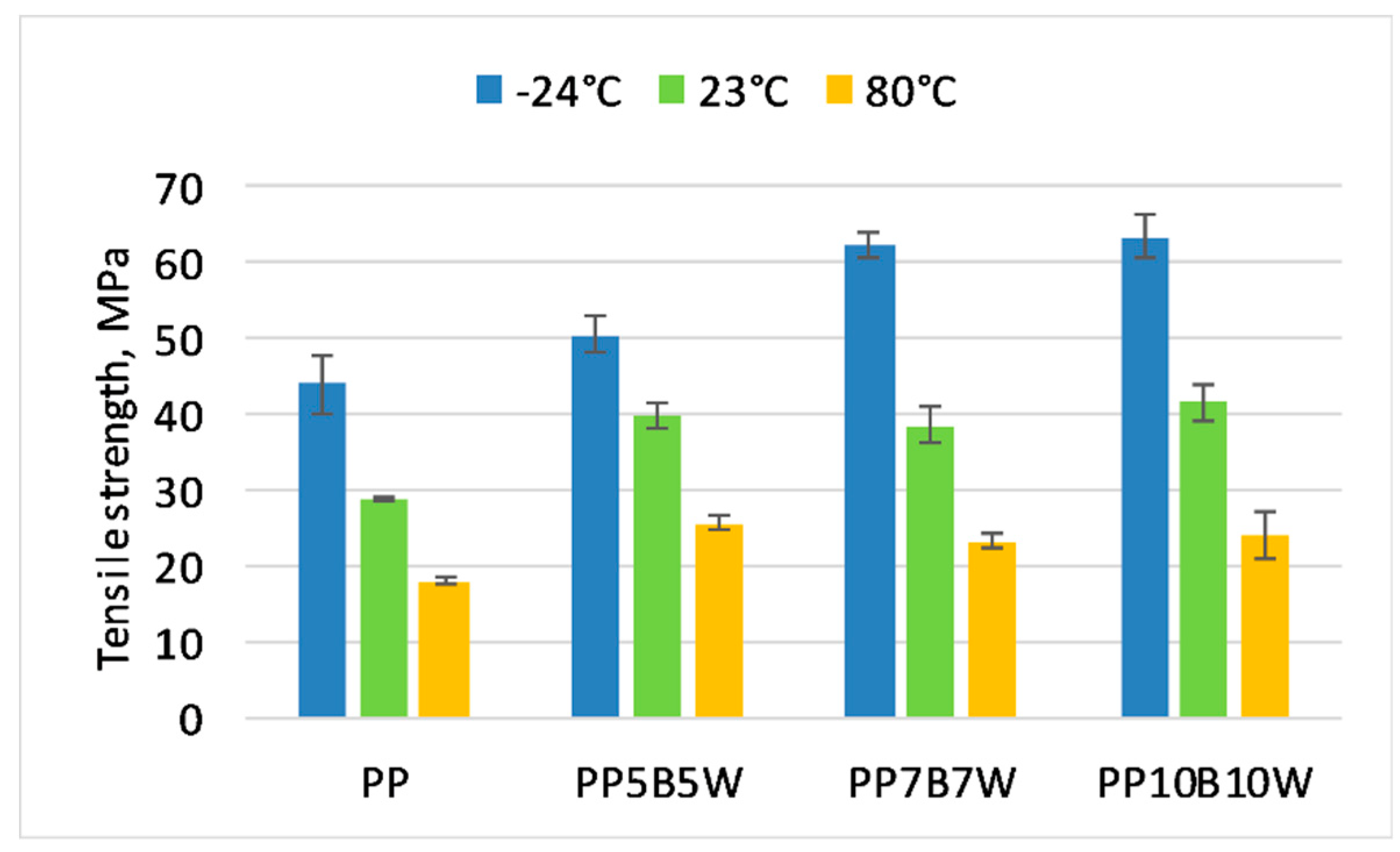
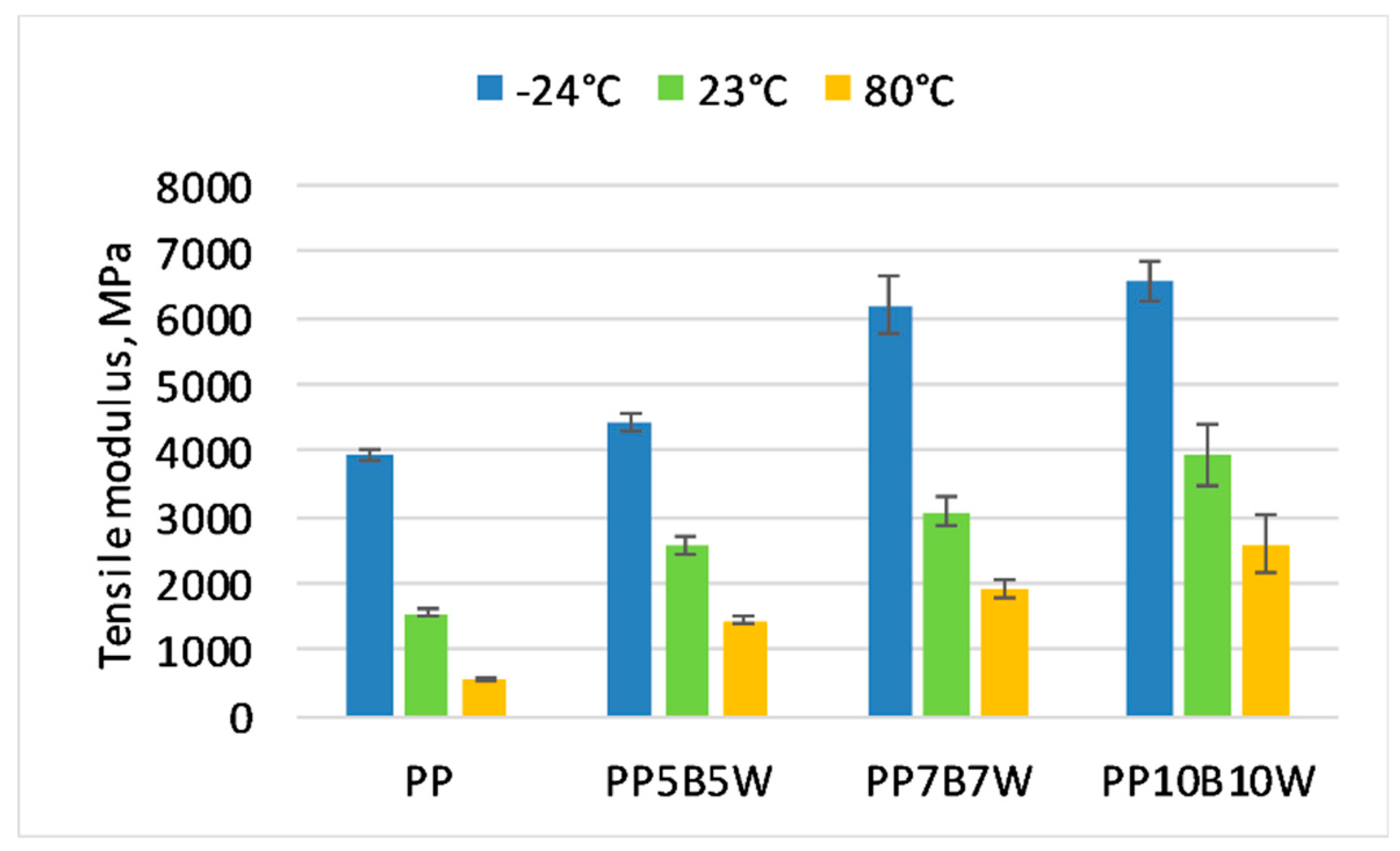
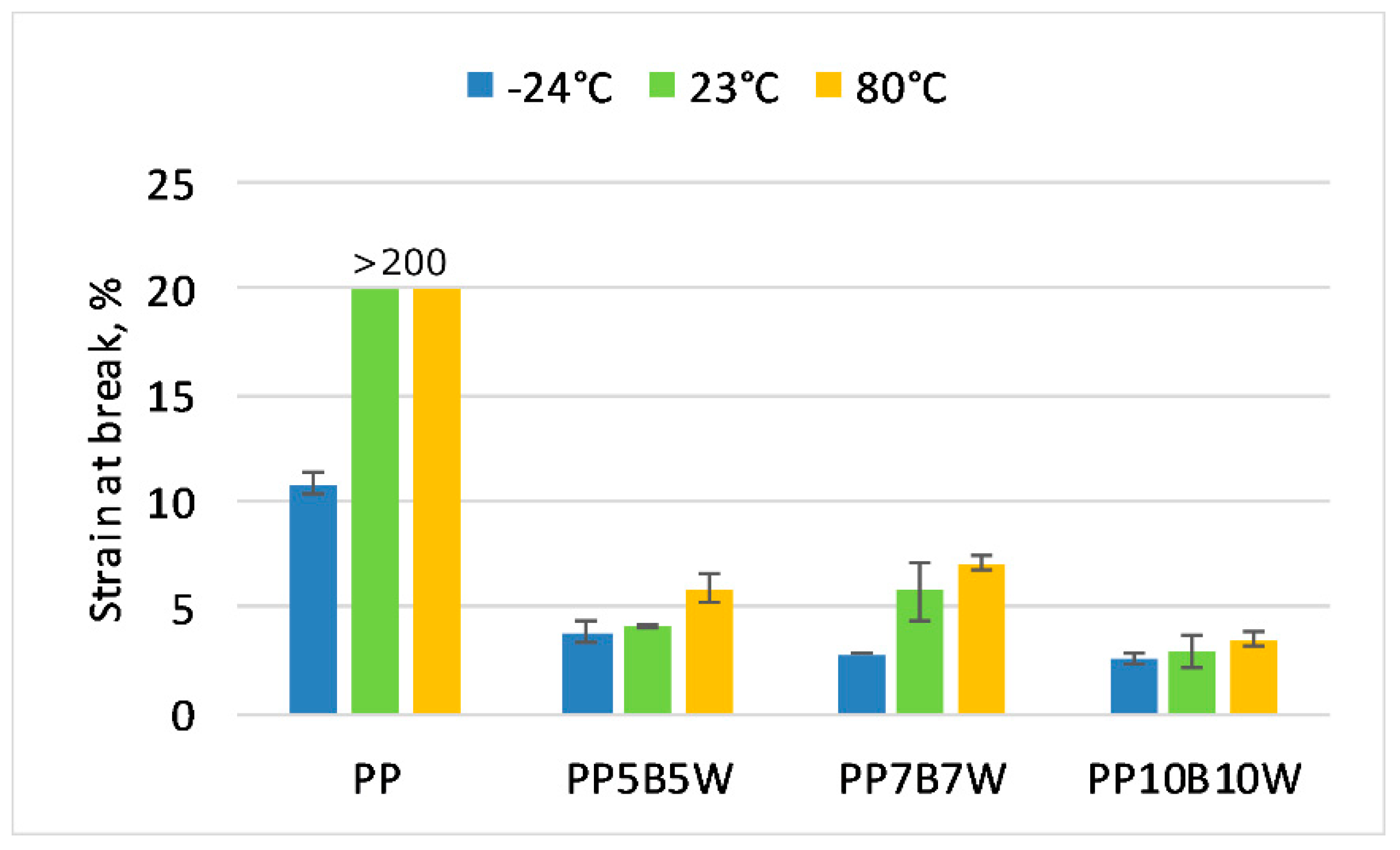
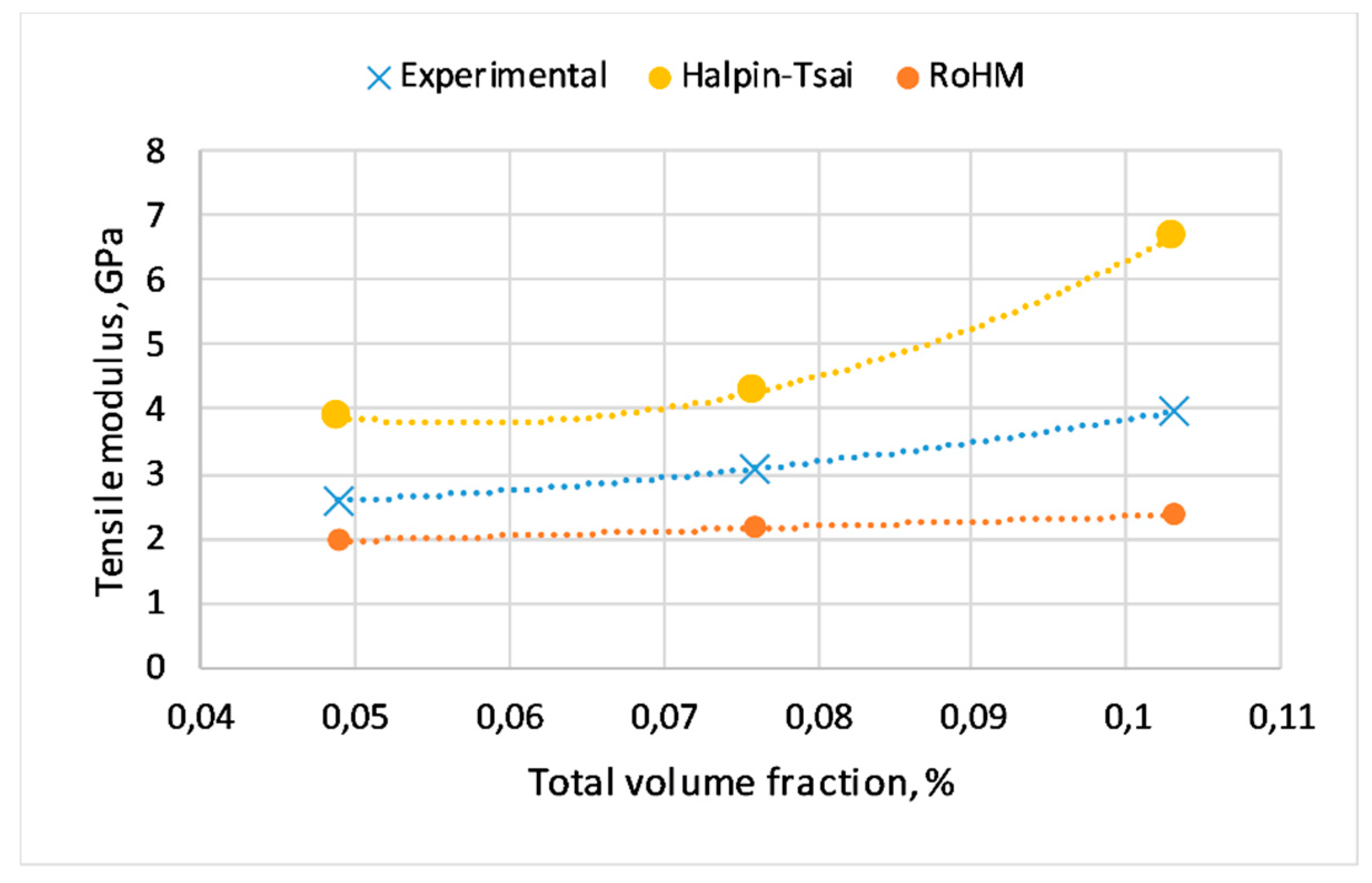
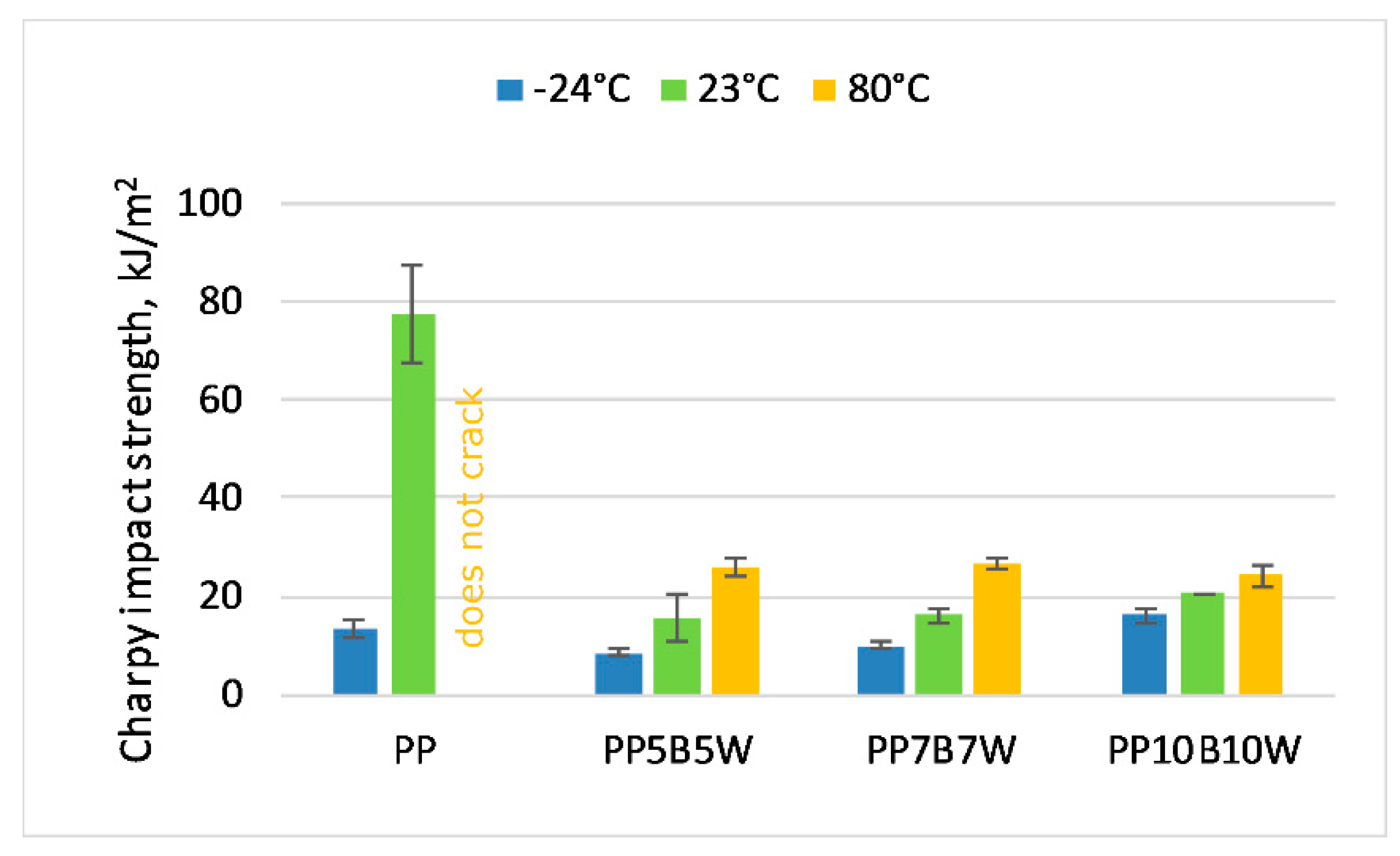

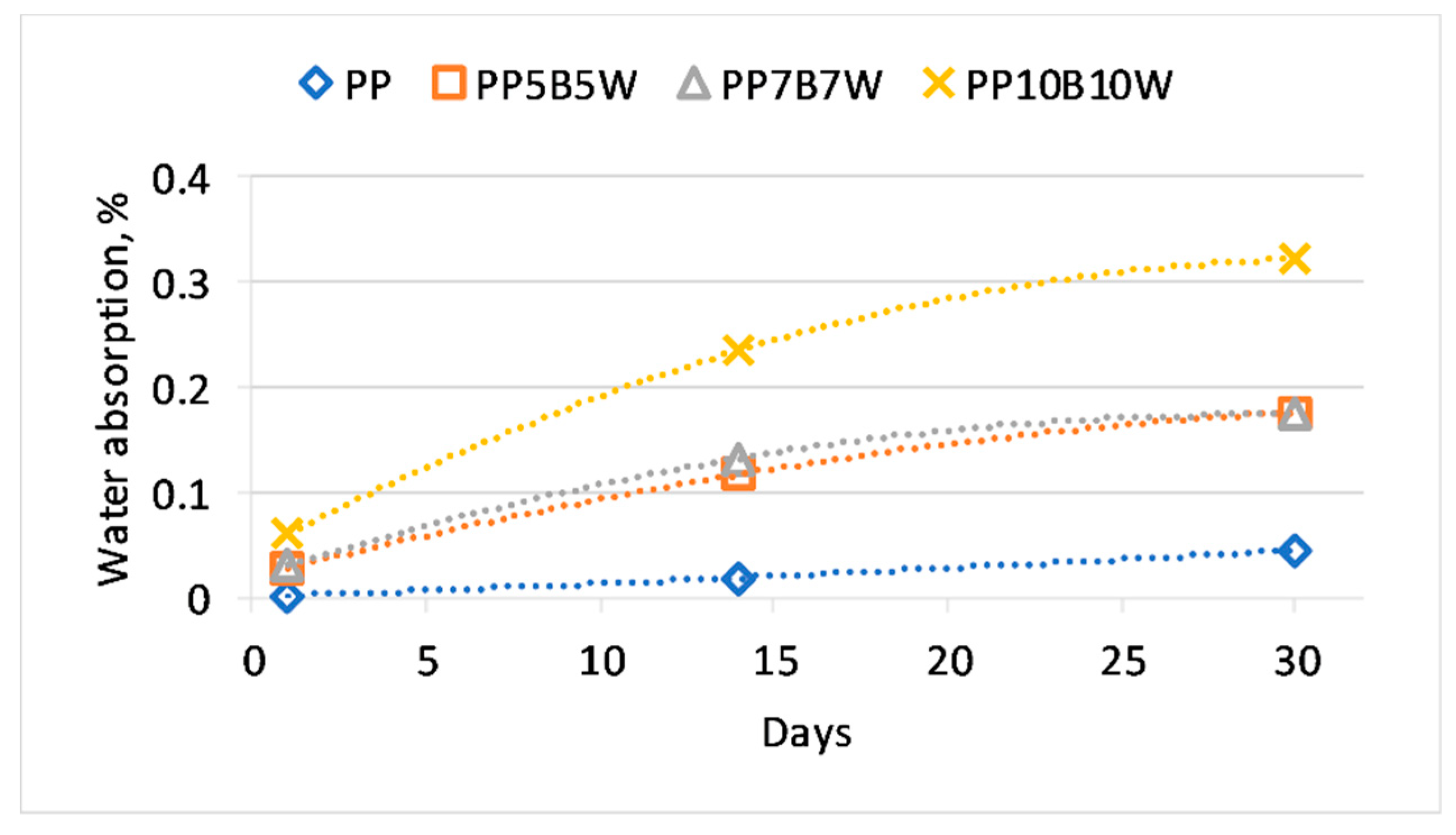

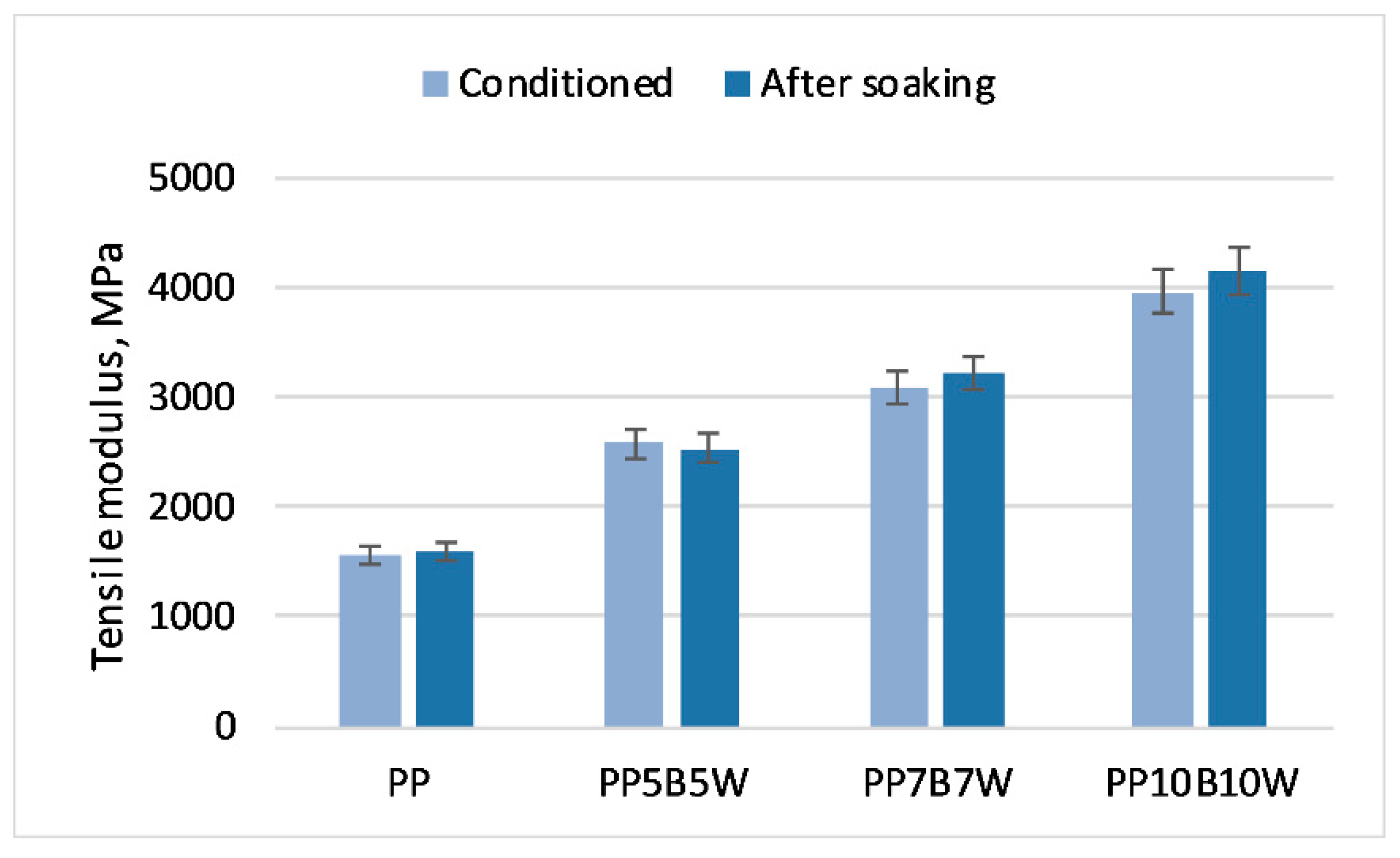
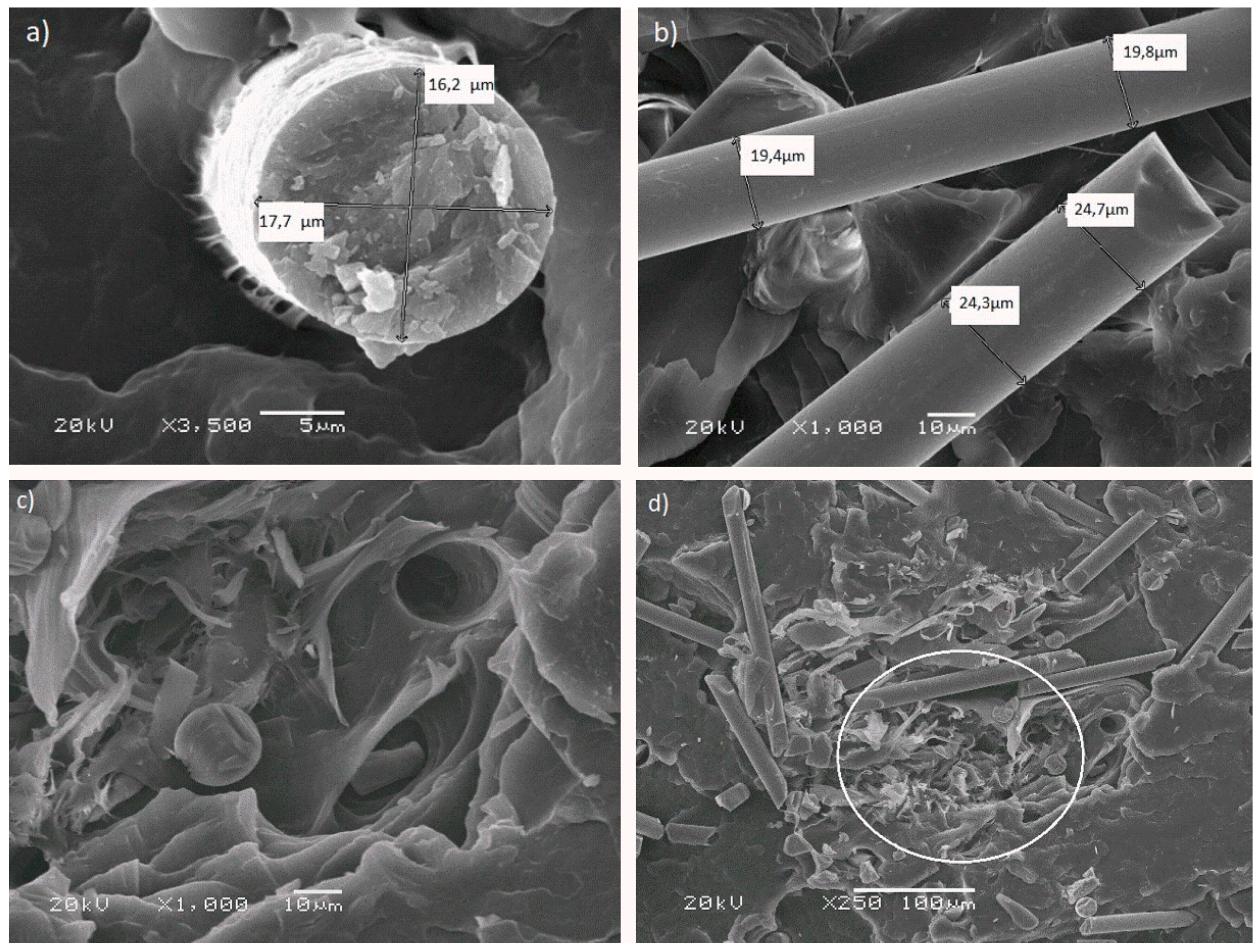
| Specimen | Matrix | Basalt Fiber Fraction, wt% | Wood Fiber Fraction, wt% | MAPP Fraction, wt% |
|---|---|---|---|---|
| PP | PP HP 500N | - | - | - |
| PP5B5W | 5 | 5 | 3 | |
| PP7B7W | 7.5 | 7.5 | 3 | |
| PP10B10W | 10 | 10 | 3 |
| Index | Density, g/cm3 | Shrinkage, % | Vicat Softening Temperature, °C | |
|---|---|---|---|---|
| Theoretical | Experimental | |||
| PP | - | 0.886 | 1.7 | 150.6 |
| PP5B5W | 0.961 | 0.947 | 0.5 | 154.3 |
| PP7B7W | 0.989 | 0.962 | 0.4 | 155.2 |
| PP10B10W | 1.017 | 1.001 | 0.3 | 157.3 |
| Index | Temperature, °C | Flexural Strength, MPa | Flexural Modulus, MPa |
|---|---|---|---|
| PP | −24 | 96.8 ± 1.2 | 4564 ± 120 |
| 23 | 48.3 ± 0.9 | 1393 ± 90 | |
| 80 | 25.4 ± 0.6 | 561 ± 75 | |
| PP5B5W | −24 | 112.9 ± 1.4 | 5783 ± 115 |
| 23 | 67.6 ± 1.2 | 2351 ± 85 | |
| 80 | 48.2 ± 0.6 | 1383 ± 95 | |
| PP7B7W | −24 | 103.5 ± 1.8 | 6256 ± 210 |
| 23 | 69.8 ± 1.3 | 3179 ± 145 | |
| 80 | 43.6 ± 1.2 | 1444 ± 98 | |
| PP10B10W | −24 | 116.6 ± 1.5 | 7295 ± 245 |
| 23 | 79.0 ± 1.1 | 4327 ± 165 | |
| 80 | 51.2 ± 1.7 | 2124 ± 110 |
| Sample | Linear Coefficient of Thermal Expansion α × 10−6, 1/K |
|---|---|
| −20 °C to 50 °C | |
| PP | 134.3 |
| PP5B5W | 73.8 |
| PP7B7W | 61.8 |
| PP10B10W | 51.9 |
© 2019 by the authors. Licensee MDPI, Basel, Switzerland. This article is an open access article distributed under the terms and conditions of the Creative Commons Attribution (CC BY) license (http://creativecommons.org/licenses/by/4.0/).
Share and Cite
Kufel, A.; Kuciel, S. Basalt/Wood Hybrid Composites Based on Polypropylene: Morphology, Processing Properties, and Mechanical and Thermal Expansion Performance. Materials 2019, 12, 2557. https://doi.org/10.3390/ma12162557
Kufel A, Kuciel S. Basalt/Wood Hybrid Composites Based on Polypropylene: Morphology, Processing Properties, and Mechanical and Thermal Expansion Performance. Materials. 2019; 12(16):2557. https://doi.org/10.3390/ma12162557
Chicago/Turabian StyleKufel, Anna, and Stanisław Kuciel. 2019. "Basalt/Wood Hybrid Composites Based on Polypropylene: Morphology, Processing Properties, and Mechanical and Thermal Expansion Performance" Materials 12, no. 16: 2557. https://doi.org/10.3390/ma12162557
APA StyleKufel, A., & Kuciel, S. (2019). Basalt/Wood Hybrid Composites Based on Polypropylene: Morphology, Processing Properties, and Mechanical and Thermal Expansion Performance. Materials, 12(16), 2557. https://doi.org/10.3390/ma12162557






